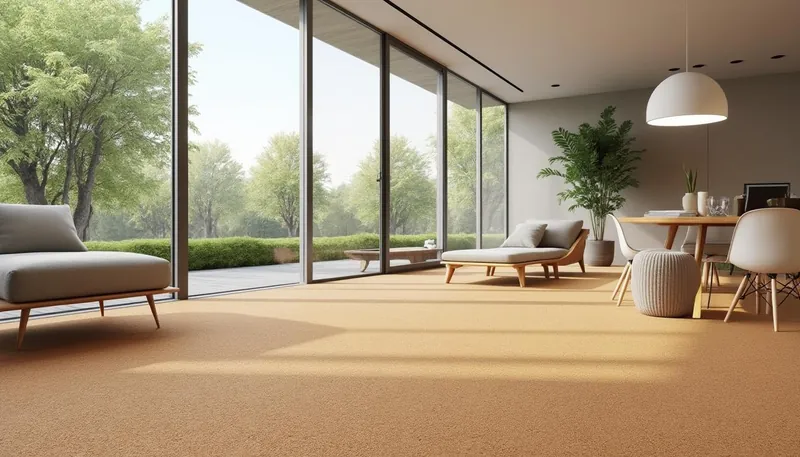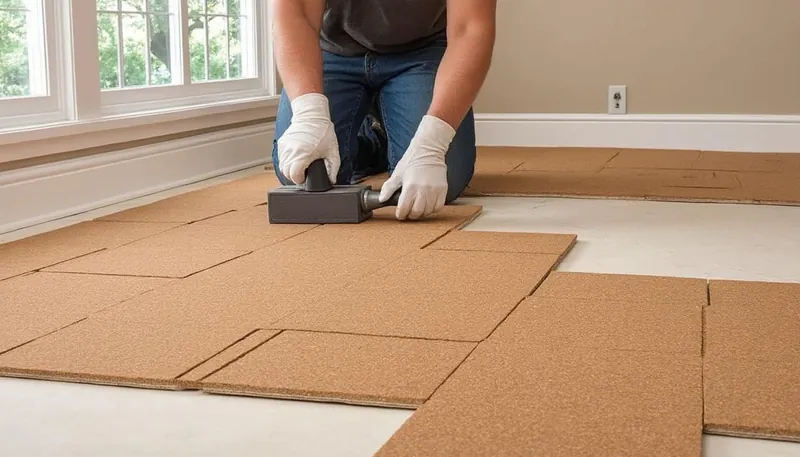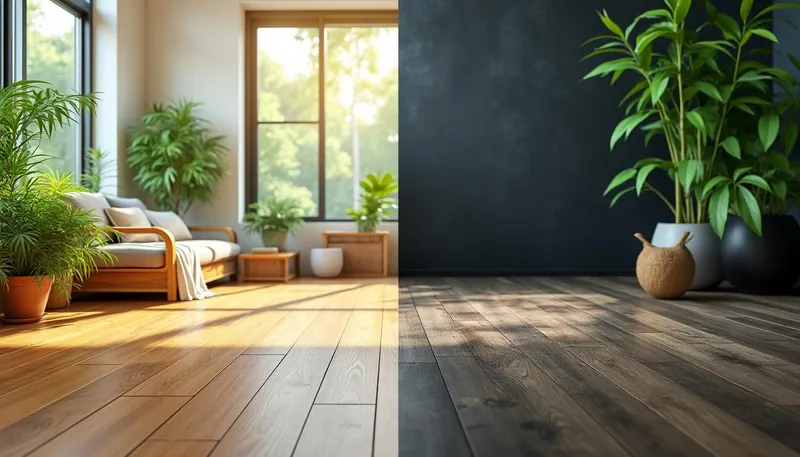Cork flooring is a trendy choice among homeowners looking for an eco-friendly and stylish flooring option. Known for its unique aesthetics and comfortable feel, cork has become increasingly popular in various settings, including high-traffic areas. However, many are left wondering: Is cork flooring durable enough for busy residential or commercial spaces? This article dives deep into the advantages and disadvantages of cork flooring, examines its longevity, and offers practical maintenance tips.
In 2025, cork flooring continues to gain traction due to its renewable nature and ability to reduce noise in bustling environments. This is especially appreciated by families with children, busy professionals, and pet owners. With brands like USFloors, Wicanders, AmCork, and others leading the market, cork is now available in numerous styles, making it easier to find the perfect fit for any interior design. The question remains: Is it the right choice for those living in high-traffic homes or commercial properties? Let’s explore further.
In Brief:
- 🌱 Cork is an eco-friendly flooring choice harvested sustainably.
- 🛋️ Offers comfort underfoot, making it suitable for busy households.
- 💧 Sensitivity to moisture affects its usage in certain areas.
- 📝 Regular maintenance is necessary to keep cork floors looking their best.
- 🔧 With proper care, cork flooring can last 10-30 years.
The Advantages of Cork Flooring in Busy Areas
Cork flooring offers a host of benefits that make it a compelling option for high-traffic areas. Its unique properties not only enhance the aesthetics of a space but also provide practical advantages. Here’s a closer look at why cork might be a smart choice for families and businesses alike:
Eco-Friendly and Sustainable
First and foremost, cork is a renewable resource, as it is harvested from the bark of the cork oak tree without harming the tree itself. This means that cork trees can be harvested every 9-12 years, allowing for sustainable production. Additionally, opting for cork flooring helps to reduce your carbon footprint, making it an environmentally conscious choice for those who prioritize sustainability.
Comfort and Noise Insulation
Cork flooring is known for its inherent cushioning, providing a comfortable surface to walk on. This soft underfoot feel can significantly reduce fatigue, especially in high-traffic areas like living rooms or commercial spaces. Furthermore, cork’s sound-absorbing properties make it an excellent choice for areas where noise reduction is crucial. Families with kids or pets can benefit from a quieter environment, while businesses may use cork to create a more pleasant atmosphere for employees and customers alike.
Thermal Insulation
This flooring material is notable for its thermal insulation properties as well. Cork retains heat, making it a cozy option during the colder months, especially in areas prone to temperature fluctuations. This characteristic can lead to lower heating costs over time, offering both comfort and savings.
Natural Resistance to Allergens
Cork is also naturally hypoallergenic, meaning it resists mold, mildew, and pests. This makes it an ideal flooring option for households with allergy-prone individuals. Families can provide a healthier living environment without the concern of airborne dust and allergens that often accumulate with traditional flooring materials.
| Advantages of Cork Flooring | Benefits |
|---|---|
| 🌱 Eco-Friendly | Sustainably harvested; reduces carbon footprint. |
| 🛋️ Comfort | Soft underfoot, reduces fatigue. |
| 💧 Insulation | Excellent thermal and sound insulation. |
| 🌬️ Hypoallergenic | Resists mold and allergens, promotes healthy living. |

Potential Drawbacks of Cork Flooring in High-Traffic Areas
While cork flooring holds a plethora of benefits, it isn’t without its drawbacks. Understanding these potential downsides is crucial for making an informed decision, especially when considering installation in busy areas:
Prone to Damage
One of the significant concerns with cork flooring is its susceptibility to dents and scratches. Heavy furniture, pet claws, or even high-heeled shoes can leave marks on the surface. While lighter dents often bounce back, deeper scratches may require repair to maintain the floor’s appearance. Homeowners might need to take precautionary measures to prevent these issues, such as using furniture pads or rugs.
Sensitivity to Moisture
Cork is naturally porous, which means it can absorb liquids if not adequately sealed. This makes it less suitable for areas like bathrooms or basements, where moisture levels can fluctuate. Additionally, any standing water may lead to swelling or warping over time. Therefore, when considering cork flooring, it’s essential to establish where the flooring will be installed to ensure longevity.
Color Fading
Prolonged exposure to direct sunlight can cause cork flooring to fade over time. It’s advisable to use UV-protective finishes or place area rugs in sun-exposed spaces to mitigate this discoloration. Otherwise, the vibrant hues of cork may lose their luster and require replacement sooner than anticipated.
| Potential Drawbacks of Cork Flooring | Concerns |
|---|---|
| 🛑 Prone to Damage | Dents and scratches can easily occur. |
| 💧 Moisture Sensitivity | Susceptible to water absorption and swelling. |
| ☀️ Color Fading | Direct sunlight can lead to discoloration. |

Maintenance and Care for Cork Flooring
To ensure that cork flooring remains in top shape, regular maintenance is critical. Here are some practical tips for keeping your cork floors looking fresh, especially in high-traffic areas:
Regular Cleaning
Using a soft-bristle broom or a vacuum designed for hardwood floors, sweep or vacuum frequently to remove dust and dirt. Failing to do so may lead to scratches on the cork’s surface. Occasionally mopping with a damp mop and a pH-balanced cleaner recipe can also help eliminate grime.
Spot Cleaning Spills
Given cork’s porous nature, cleaning spills promptly is essential. Use a soft cloth or sponge to blot up spills immediately to avoid potential staining. Remember that standing liquid can lead to significant issues down the line, so keeping an eye on spills is important.
Protective Measures
Applying a sealant every 3-5 years can also help prolong the lifespan of cork flooring. Furthermore, using furniture pads can help minimize dents from heavy pieces. To prevent color fading, think about setting up blinds or UV-filtering curtains, reducing direct sunlight exposure. Here’s a quick checklist to keep in mind:
- 🧹 Regularly sweep/vacuum the floors.
- 🧼 Spot clean spills immediately.
- 🔒 Seal every 3-5 years.
- 🪑 Use furniture pads under heavy objects.
- 🌞 Install UV-protective window treatments.
Longevity and Performance of Cork Flooring
Now, let’s talk about how long cork flooring can actually last in a high-traffic area. With the right care and maintenance, cork flooring can last anywhere from 10 to 30 years or even longer, which is quite respectable compared to many other flooring types. Here’s how various factors can affect its overall lifespan:
Quality of Cork
The durability of cork flooring heavily relies on its quality. Solid cork planks tend to wear better over time and can often be sanded and refinished, extending their lifespan. Brands like Globus Cork and WE Cork offer high-quality options, making them a great choice for those prioritizing longevity. On the other hand, engineered cork flooring may have limitations regarding refinishing, although they often offer improved moisture resistance.
Foot Traffic Level
The amount of foot traffic also plays a critical role in determining the lifespan of cork flooring. While it can handle moderate traffic, heavy traffic areas—like entranceways or bustling corridors—will experience wear more quickly. High-quality finishes and thicker wear layers from brands like Cali Bamboo or Mondo might provide better protection.
Maintenance Practices
Regular maintenance, as noted earlier, is essential to extend the lifespan of cork flooring. Timely resealing and addressing minor scratches immediately can make a significant difference in how well the floor upholds over time. In high-traffic scenarios, dedicating a bit more effort into care can yield a long-lasting flooring solution.
| Factors Affecting Cork Flooring Longevity | Impact on Lifespan |
|---|---|
| 🪵 Quality of Cork | Higher quality offers better durability and refinishing options. |
| 👣 Foot Traffic Level | More traffic leads to faster wear and degradation. |
| 🧼 Maintenance Practices | Timely care and maintenance extend the floor’s lifespan. |
Frequently Asked Questions
Is cork flooring suitable for kitchens?
Cork can be used in kitchens if properly sealed to manage spills and moisture, though care is necessary due to potential water damage.
How do you clean cork flooring?
Regular sweeping and spot cleaning spills are essential. Mop with a damp cloth and avoid harsh chemicals that can damage the surface.
Does cork flooring require refinishing?
Yes, solid cork floors can be refinished multiple times, while engineered cork has limited refinishing options depending on wear.
How long will cork flooring last?
With proper care, cork flooring can last between 10 to 30 years or more, depending on quality and maintenance efforts.
Can pets damage cork flooring?
While cork is resilient, scratches from pet claws can damage the surface. Choosing quality cork and using furniture pads can minimize such issues.


